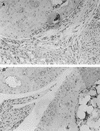Clearance of Borrelia burgdorferi may not be required for resistance to experimental lyme arthritis
- PMID: 9573090
- PMCID: PMC108164
- DOI: 10.1128/IAI.66.5.2065-2071.1998
Clearance of Borrelia burgdorferi may not be required for resistance to experimental lyme arthritis
Abstract
Infection of inbred mouse strains with Borrelia burgdorferi results in the development of experimental Lyme arthritis. The degree of arthritic pathology has been suggested to correlate with the level of spirochete burden within tissues. To investigate this further, we infected resistant DBA/2 (DBA) and susceptible C3H/HeJ (C3H) mice in the hind footpads and monitored arthritis development for 21 days. To quantitate levels of spirochetes within tissues, we created a competitive PCR molecule containing modified ospA and fla gene segments. C3H mice developed severe arthritis of the tibiotarsal joints, while DBA mice developed only mild inflammation throughout the experimental period. At day 21, when the gross size and histologic composition of ankles revealed significant differences in arthritis between the strains, there was little difference in levels of spirochete DNA as determined by competitive PCR. Cultures of ankle tissue at day 21 were also uniformly positive in both C3H and DBA animals and contained relatively similar levels of spirochetes. These results indicate that the presence of spirochetes in the ankles of experimental animals is not sufficient for arthritis development. Since arthritic and nonarthritic animals can harbor relatively equal spirochete burdens yet retain their distinct phenotypic outcomes, an aberrant or overly exuberant immune response may be an additional requirement for pathology in arthritis-prone mice.
Figures





Similar articles
-
Heritable susceptibility to severe Borrelia burgdorferi-induced arthritis is dominant and is associated with persistence of large numbers of spirochetes in tissues.Infect Immun. 1994 Feb;62(2):492-500. doi: 10.1128/iai.62.2.492-500.1994. Infect Immun. 1994. PMID: 8300208 Free PMC article.
-
Distinct characteristics of resistance to Borrelia burgdorferi-induced arthritis in C57BL/6N mice.Infect Immun. 1998 Jan;66(1):161-8. doi: 10.1128/IAI.66.1.161-168.1998. Infect Immun. 1998. PMID: 9423853 Free PMC article.
-
The DBA/1 strain is a novel mouse model for experimental Borrelia burgdorferi infection.Clin Vaccine Immunol. 2012 Oct;19(10):1567-73. doi: 10.1128/CVI.00251-12. Epub 2012 Aug 1. Clin Vaccine Immunol. 2012. PMID: 22855391 Free PMC article.
-
Autoimmune mechanisms in antibiotic treatment-resistant lyme arthritis.J Autoimmun. 2001 May;16(3):263-8. doi: 10.1006/jaut.2000.0495. J Autoimmun. 2001. PMID: 11334491 Review.
-
Host-pathogen interactions and the pathogenesis of murine Lyme disease.Curr Opin Rheumatol. 2002 Jul;14(4):399-403. doi: 10.1097/00002281-200207000-00011. Curr Opin Rheumatol. 2002. PMID: 12118174 Review.
Cited by
-
T Cells Exacerbate Lyme Borreliosis in TLR2-Deficient Mice.Front Immunol. 2016 Nov 3;7:468. doi: 10.3389/fimmu.2016.00468. eCollection 2016. Front Immunol. 2016. PMID: 27857714 Free PMC article.
-
Impact of E. muris infection on B. burgdorferi-induced joint pathology in mice.Front Immunol. 2024 Aug 20;15:1430419. doi: 10.3389/fimmu.2024.1430419. eCollection 2024. Front Immunol. 2024. PMID: 39229265 Free PMC article.
-
Noncoding RNAs and chronic inflammation: Micro-managing the fire within.Bioessays. 2015 Sep;37(9):1005-15. doi: 10.1002/bies.201500054. Epub 2015 Aug 6. Bioessays. 2015. PMID: 26249326 Free PMC article. Review.
-
Adenoviral delivery of interleukin-10 fails to attenuate experimental Lyme disease.Infect Immun. 2008 Dec;76(12):5500-7. doi: 10.1128/IAI.00808-08. Epub 2008 Sep 29. Infect Immun. 2008. PMID: 18824530 Free PMC article.
-
Infection of Interleukin 17 Receptor A-Deficient C3H Mice with Borrelia burgdorferi Does Not Affect Their Development of Lyme Arthritis and Carditis.Infect Immun. 2015 Jul;83(7):2882-8. doi: 10.1128/IAI.00533-15. Epub 2015 May 4. Infect Immun. 2015. PMID: 25939508 Free PMC article.
References
-
- Armstrong A L, Barthold S W, Persing D H, Beck D S. Carditis in Lyme disease susceptible and resistant strains of laboratory mice infected with Borrelia burgdorferi. Am J Trop Med Hyg. 1992;47:249–258. - PubMed
-
- Barthold S, Moody K, Beck D. Susceptibility of laboratory rats to isolates of Borrelia burgdorferi from different geographic areas. Am J Trop Med Hyg. 1990;42:596–600. - PubMed
-
- Barthold S W, Moody K D, Terwilliger G A, Duray P H, Jacoby R O, Steere A C. Experimental Lyme arthritis in rats infected with Borrelia burgdorferi. J Infect Dis. 1988;157:842–846. - PubMed
Publication types
MeSH terms
Grants and funding
LinkOut - more resources
Full Text Sources
Medical

